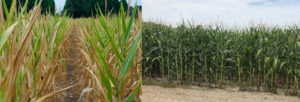By: Bryant Spivey
County Extension Director – Johnston County Center
Drought is not a complicated term and most people know what it means, at least to them. When speaking of a drought some people will immediately think of a team or athlete that is experiencing a slump, while others may think of a business that has a decline in sales or performance. Webster’s dictionary defines drought as, “a period of dryness especially when prolonged; specifically: one that causes extensive damage to crops or prevents their successful growth.” As we watch the news we often hear of drought or extreme dry periods, however it most often relates to water levels in nearby reservoirs like Falls Lake. If we think back to 2007, NC experienced a severe drought and the water levels in Falls Lake got extremely low affecting water use in Raleigh and areas all across NC.
For most of us when we need water we turn on the faucet and get what we need. Some even run sprinklers in the yard or have automatic irrigation systems to ensure that the grass stays green and lush. On the farm things are just not that simple. Yes, farmers do use irrigation especially on vegetable crops, nursery crops, and high value crops. However, in Johnston County, water resources, irrigation equipment, and labor is just not sufficient to overcome the effects of drought.

Today we even have a drought monitor mechanism to keep tabs on drought conditions. To view North Carolina conditions, you can look online at www.ncdrought.org. On this drought monitoring site, you can see a color-coded map illustrating what areas are experiencing drought and to what degree. The drought ratings go from no designation to abnormally dry all the way up to exceptional drought as the most severe.
Today if you ride around Johnston County you will find brown grass (unless it is irrigated), wilting soybeans, tobacco, and sweet potatoes, and corn that has been severely damaged by dry weather. If you are growing vegetables in your own garden you may have noticed lower yields, damaged fruit, or smaller ears of corn. If you ever shuck an ear of corn and notice areas where the kernels are absent, this is typically due to poor pollination which often occurs in dry weather. So, we have established that it is very dry in Johnston County. However, if you look at the most recent drought monitor it shows about 8-10 counties north of Charlotte, NC that are designated as “abnormally dry” the mildest drought indication. According to the drought monitor, there is no indication of drought in Johnston County at the present time. Every farmer in our area knows that from a farm standpoint we are currently in a very damaging drought situation. So, why does the drought monitor not recognize this?
The drought monitor is designed to recognize long-term weather trends and depletion of groundwater while our crops are dependent on the moisture in the top 1-2 feet of the soil. We had good rainfall early in the season followed by dry conditions in late June and early July. Our shallow rooted crops in well-drained soils are now suffering severely. So, the drought monitor is not always the best indicator of moisture stress or drought stress to our crops.

What does the mean to a farmer? It is to say the least very stressful. Farmers invest their time and labor into the crop in hopes of good rainfall especially in June, July, and August. If those rains do not come, it affects the farmer’s bottom line. Farmers do carry crop insurance which helps to cover losses during periods of unfavorable weather. However, most farmers will tell you that this insurance is only a partial coverage that will not insure profit. In most cases, it will only cover the costs associated with planting and growing the crop. So, to a farmer it means their livelihood.
So, the next time you hope it does not rain and spoil the cookout or a weekend at the beach think of the farmers and their livelihood. And if that is this weekend, please pray for rain. We need it badly.











